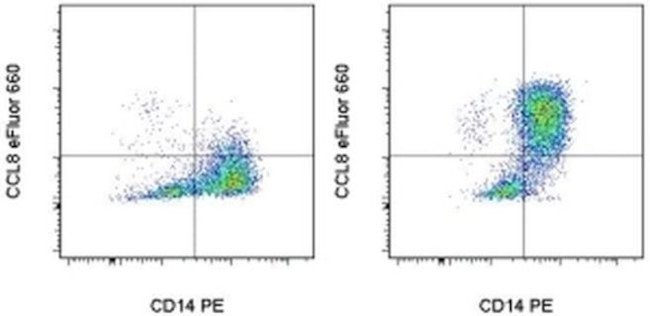Search Thermo Fisher Scientific
Invitrogen
CCL8 (MCP-2) Monoclonal Antibody (DWZEE), eFluor™ 660, eBioscience™
FIGURE: 1 / 1
CCL8 (MCP-2) Antibody (50-9789-42) in Flow

Product Details
50-9789-42
Species Reactivity
Published species
Host/Isotype
Recommended Isotype Control
Class
Type
Clone
Conjugate
Excitation/Emission Max
Form
Concentration
Purification
Storage buffer
Contains
Storage conditions
Shipping conditions
RRID
Product Specific Information
Description: This DWZEE monoclonal antibody reacts with human CCL8. CCL8, also known as MCP-2 (Monocyte Chemotactic Protein 2), is a member of the CC- subfamily of chemokines and is most closely related to CCL2 (MCP-1) and CCL7 (MCP-3). They are secreted by a variety of cell types in response to inflammatory stimuli and play critical roles in the recruitment of leukocytes to areas of inflammation. While all three MCP proteins are potent chemoattractants of monocytes and T cells, CCL7 appears to have the broadest range of activity, as it has also been demonstrated to attract activated NK cells, eosinophils, basophils, and neutrophils. CCL8 has also been demonstrated to attract NK cells, eosinophils, and basophils, but requires higher concentrations to do so. CCL8 signals via the g protein-coupled receptor CCR5, which is shared with other CC-chemokines. CCR5 is the primary co-receptor for HIV entry, which the virus binds through the gp120 envelope protein. All CCR5 ligands demonstrate potent inhibition of virus entry into the cell, both through steric hindrance of gp120-CCR5 interaction, and ligand-mediated receptor internalization.
Applications Reported: This DWZEE antibody has been reported for use in intracellular staining followed by flow cytometric analysis.
Applications Tested: This DWZEE antibody has been pre-titrated and tested by intracellular staining followed by flow cytometric analysis of normal human peripheral blood monocytes. This can be used at 5 µL (0.125 µg) per test. A test is defined as the amount (µg) of antibody that will stain a cell sample in a final volume of 100 µL. Cell number should be determined empirically but can range from 10^5 to 10^8 cells/test.
eFluor® 660 is a replacement for Alexa Fluor® 647. eFluor® 660 emits at 659 nm and is excited with the red laser (633 nm). Please make sure that your instrument is capable of detecting this fluorochome.
Excitation: 633-647 nm; Emission: 668 nm; Laser: Red Laser.
Filtration: 0.2 µm post-manufacturing filtered.
Target Information
This antimicrobial gene is one of several chemokine genes clustered on the q-arm of chromosome 17. Chemokines form a superfamily of secreted proteins involved in immunoregulatory and inflammatory processes. The superfamily is divided into four subfamilies based on the arrangement of N-terminal cysteine residues of the mature peptide. This chemokine is a member of the CC subfamily which is characterized by two adjacent cysteine residues. This cytokine displays chemotactic activity for monocytes, lymphocytes, basophils and eosinophils. By recruiting leukocytes to sites of inflammation this cytokine may contribute to tumor-associated leukocyte infiltration and to the antiviral state against HIV infection.
For Research Use Only. Not for use in diagnostic procedures. Not for resale without express authorization.
How to use the Panel Builder
Watch the video to learn how to use the Invitrogen Flow Cytometry Panel Builder to build your next flow cytometry panel in 5 easy steps.
Bioinformatics
Protein Aliases: C-C motif chemokine 8; chemokine (C-C motif) ligand 8; HC14; MCP-2; Monocyte chemoattractant protein 2; Monocyte chemotactic protein 2; small inducible cytokine subfamily A (Cys-Cys), member 8 (monocyte chemotactic protein 2); Small-inducible cytokine A8
Gene Aliases: CCL8; HC14; MCP-2; MCP2; SCYA10; SCYA8
UniProt ID: (Human) P80075
Entrez Gene ID: (Human) 6355

Performance Guarantee
If an Invitrogen™ antibody doesn't perform as described on our website or datasheet,we'll replace the product at no cost to you, or provide you with a credit for a future purchase.*
Learn more
We're here to help
Get expert recommendations for common problems or connect directly with an on staff expert for technical assistance related to applications, equipment and general product use.
Contact tech support

